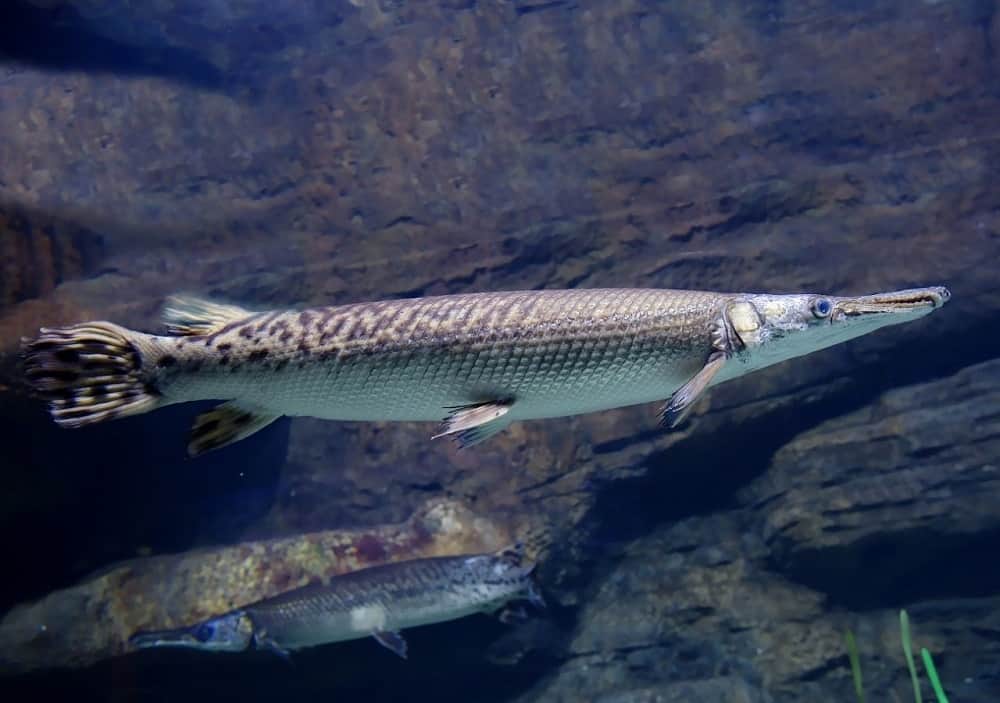Also known as a Billy Gar or Longnose Garpike, the Longnose Gar is a ray-finned fish pertaining to the family Lepisosteidae. This means that its fins are composed of webs off skin structured by hard spines, rather than the fleshy, free-moving fins of lobe-finned fish.
Native to the freshwater lakes, brackish coastal waters, swamps, and slow-moving backwaters of Northern and Central America, their genus is thought to be roughly 100,000,000 years old.

As such, some suggest that they’re quite primitive creatures, but in reality, they’re highly evolved fish with exquisite adaptations, such as the ability to breathe air as well as water.
Care Guide
As you can probably tell from the look of them, Longnose Gars are quite tough fish, so even though they’re quite an unusual addition to an aquarium, they’re reasonably easy to take care of.
But It’s not necessarily the care schedule you should be worried about. When fully grown, these things are absolute beasts, and it’s often just not practical or even possible for hobbyists to accommodate them.
Tank Size
The best captivity-based habitat for these fish isn’t a tank at all, but a large, deep pond. As that’s not really an option for most aquarists, let’s discuss just how big a tank you’ll need to keep a Longnose Gar happy.
It’s best to stick with something quite modest for young Juveniles. They can spook quite easily, and if they have the room to reach full speed before colliding with the glass wall, they’ll almost certainly injure or possibly even kill themselves.
In light of this, incrementally stepping up your tank size to accommodate growth is essential. To house a single adult Longnose Gar, you’re looking at an aquarium that measures around 4 feet wide and 8 feet long. That’s about 500-600 gallons!
However, if you’ve got a particularly large specimen on your hands, you may need to go even bigger than that — we’re talking 1000 gallons +.
Tank Mates
Longnose Gars need only flash those gnashers of theirs to let us know that they’re consummate hunters, which can pose a problem when trying to find them suitable tank mates.
If you want to prevent your new additions to the tank from becoming dinner, you should be looking for fish of equal size with peaceful dispositions. The Longnose Gar won’t mess with anything that could potentially put up a fight, such as…
- Oscar
- Pacu
- Bishir
- Knifefish
- Giant Gourami
- Adult Centrarchid
- Texas Cichlid
Always keep a close eye on proceedings after introducing a tank mate, as even the ones that seem like they’d get on with your Longnose Gar can cause tension, amounting to conflict and injury.
Same Species Tanks
It’s generally considered fine to raise Longnose Gars in groups. With the exception of the Gator Gar, you can even mix it up a bit if you like and introduce multiple different species of Gar.
While they’re not overtly social creatures, they have been known to form strong bonds with tank mates of a similar size and species.
Things do get a little messy come feeding time, though. They just get so excited, they’ll sometimes catch each other’s fins when chomping down on their dinner. The injuries aren’t normally that severe but can worsen over time.
Some owners report that eventually, their Gars lost the majority of their rear fins, but on a positive note, they heal quickly and never seem too put out by their war wounds.
Water Parameters
Longnose Gars are incredibly resilient when it comes to water types. As long as they’re getting fed, they’re really not too picky about what they’re in.
They prefer colder water but can handle heat just fine. They lean towards the acidic end of the pH scale, but a little bit of alkaline never hurt them. And if they could, they’d choose softer water, but slightly harder water isn’t an issue either.
Let’s check out just how wide their comfortable ranges are…
- Water Temperature: 60 – 68° F (15.5 – 20° C) should be fine, but if you want to introduce some tank mates that prefer warmer water, you can go as high as 75° F (23.8° C).
- pH: 6.5 – 8
- Water Hardness: 10 – 20 dKH
One thing I should say before we move on. Juveniles really don’t like ammonia at all, so you’ll benefit from placing some zeolite in one of your filter’s media compartments.
What to Put In Their Tank
Decorating your Longnose Gar’s tank can be tricky because they’re just so dang long. Anything that restricts their movements or takes up too much space in the tank is strictly out of the question, so a less-is-more approach is the best course of action.
They tend to linger at the bottom of the tank, so a soft, sandy substrate will keep them nice and cozy, but there’s no real problem with using rocks if that’s what you or tank mates prefer.
It’s best to keep vegetation quite sparse and limit the length of the plants that you choose, otherwise, your Longnose Gar may become somewhat tangled. It’s important that you place most of your vegetation around the edges of the aquarium, so they have plenty of central room to swim.
Driftwood should play a big role in your tank, as it’s nonrestrictive, and they’d encounter plenty of it in their natural habitat.
In terms of filtration, you’re going to need something powerful to cycle such a large quantity of liquid. Longnose Gars prefer calm waters, so a quality sponge filter will be perfect, as they cause little to no turbulence.
Common Diseases
Longnose Gars have great general health and aren’t predisposed to any disease, but that’s not to say they can’t get ill if not cared for correctly. For example, poor water monitoring can lead to ammonia poisoning, giving the fish an unnatural curve that can often be mistaken for a broken spine.
The viral disease, Lymphocystis, is another threat to your Longnose Gar. It usually makes its way into your aqua ecosystem by catching a ride on new tank mates or food. To reduce the risk of infection, it’s good practice to quarantine any new fish or live snacks for a while before introduction to the primary tank.
Food and Diet
Longnose Gars like something meaty to sink their teeth into, so feel free to feed them chopped-up fish or shellfish — tilapia seems to be a particular favorite of theirs.
In the wild, they’ll eat anything smaller than themselves, so you can get creative with their diet, but they will refuse dry food and may take a fair amount of time to warm to frozen foods.
If possible, feed them live food, as the “hunt” gives them a great deal of satisfaction, and they need a protein-rich diet to stay in top shape.
Lifespan
Possibly one of the most challenging aspects of Longnose Gar ownership is that they live for 15 – 20 years. A lot can happen in two decades, so it’s impossible to say if you’ll be able to give them the care they need for their whole life.
Some owners even reported that their Longnose Gar went on even longer, almost reaching the age of 40, so yeah…a Longnose Gar is for life, not just for Christmas.
Appearance
Longnose Gars have very thin, slender, torpedo-shaped bodies, and as I’m sure you have gathered from the name, they have an elongated beak-like snout hiding numerous sharp, conical teeth situated in the upper jaw.
Their base color ranges from olive-brown to green, with a white or silvery underside. Dark spots line its body and fins, fading gradually towards the head, and it’s covered snout to tail in tough ganoid scales.
Size
While they can grow as long as 6 feet in the wild, captive Longnose Gars usually reach somewhere between 28 – 48 inches (2.3 – 4ft). Besides the ferocious Alligator Gar, they’re the largest Gar species on the planet.
Behavior and Temperament
Longnose Gars are moderate-to-highly aggressive depending on the circumstances. They’ll waste no time chomping on any living things smaller than them, but their ferocity as hunters is often mistaken for confidence and an outgoing disposition. On the contrary, they’re very timid, easily-spooked creatures.
They’re nocturnal, so you may not see all that much of them in the daytime, but when they do appear, they’ll typically hang quite low in the tank.
Rather than using speed or agility when hunting, they’ll remain motionless, waiting for an opportunity to snatch up their prey in their toothy jaws. They’re also partial to the odd jump now and then, so a weighted aquarium lid is a must.
As they’re capable of breathing air, they like to surface from time to time and fill their gills, so make sure you give them room above the water level to do so.
Breeding
Longnose Gars only reproduce after migration upstream, so breeding them in captivity using a hobbyist setup isn’t an option.
Gender Differences: Male vs Female
Being that they’re sexually dimorphic, it’s not at all difficult to tell male and female Longnose Gars apart. Females are almost always significantly larger on all fronts, including weight, body length, and fin length. Yet despite their larger form, females don’t reach sexual maturity until the age of 6, while males are ready to breed by the age of 2.
Fun Facts
- Longnose Gar can live to the ripe old age of 39.
- They can breathe both water and air, which means they can survive in oxygen-deprived bodies of water.
- Their genus is over 100,000,000 years old (jeez, that’s a lot of zeros).
- They’re the second-largest species of Gar after the Alligator Gar.
- They can grow to a whopping 6ft in length.
- They have rows of sharp, conical-shaped teeth running along both sides of their upper jaw.








